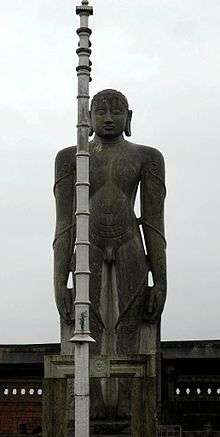Jain Bunt
| Regions with significant populations | |
|---|---|
| Languages | |
|
Tulu Kannada Konkani | |
| Religion | |
| Jainism | |
| Related ethnic groups | |
| Bunt |
| Part of a series on |
| Jainism |
|---|
 |
|
Jain prayers |
|
Ethics |
|
Major figures |
|
Major sects |
|
Festivals |
|
Pilgrimages |
|
|
The Jain Bunt are a Jain community from Karnataka, India. They are traditionally defined as a subdivision of the Bunt community.[1] It is believed that the Jain Bunts also have the highest per capita income in India.[2] They have a feudal and martial heritage, and many erstwhile royalty of the Tulu Nadu region were Jain Bunts.[3]
Origin
Some Jain Bunts are hereditary trustees and administrators of Hindu Temples, an example being at the Dharmasthala Temple, whose hereditary administrators are the Pergade family.[4]
Tradition
Jain traditions


The Jain Bunt are Digambaras. Achieving moksha or liberation is the highest goal of life for the Jains. Jain monastics and renouncers of worldly life are highly revered, especially Bahubali, a king who turned into an ascetic. His virtues are greatly extolled in legends. Huge, monolithic statues have been erected by the Jain Bunts in his honor throughout their recorded history.[5] The oldest among them is located in Karkala. Standing about 42 feet tall, it was erected by the Jain Bunts as per the wishes of a pontiff named Lalitakeerti in 1432. Another statue of Bahubali standing about 35 feet was erected in Venur in 1604 by the Jain Bunt ruler Timma Ajila. The most recently erected statue lies in Dharmasthala and is about 39 feet tall. Mahamastakabhisheka rituals are held once in 12 years at the site of these statues. Jain temples, called basadi and derasar, are numerous in the region and were built by various Jain Bunt rulers. The most famous among them is the Saavira Kambada Basadi located in Moodabidri.[3] Jain Bunts are strict vegans and do not consume anything after sunset or eat root vegetables.
Matrilineal inheritance
Jain Bunts follow a system of matrilineal inheritance called Aliyasantana in Tulu. This is in sharp contrast to other Jain communities. Jains attribute their matrilineality to Bhutala Pandya, a legendary king of unknown antiquity.
Daivaradhane
Along with Hindu gods and Jain tirthankaras, Jain Bunts worship spirit deities which are of both puranic and local origins. They spirit deities are seen as protectors. Annual ritual dances called Bhuta Kola or Dharma Da Nema are performed in the honor of them. A spirit deity called Annappa Panjurli, who is widely revered in the Tulu region, is associated with the Jains and the highly revered Dharmasthala Temple, which is managed by a Jain Bunt family called the Pergades, the members of which use the title of Heggade. The eldest male member of this family inherits the position of dharmadhikari - the one who dispenses justice on behalf of Mañjunātha (Shiva) and Ammavaru, the main deities of the temple. The succession to the post of dharmadikari is according to the laws of aliyasantana.
Nagaradhane
Jain Bunts greatly revere the cobras. They are considered to be sacred creatures and embodiment of Hindu serpent deities like Ananta, Vasuki, Takshaka etc. These snake gods are worshipped in sacred groves called Naga Bana. Rituals of Nagaradhane are performed in honor of them.,
Notable people
See also
| Wikimedia Commons has media related to Jain Bunt. |
References
- ↑ Kumar Suresh Singh, Anthropological Survey of India (2004). People of India: Maharashtra, Volume 1. Popular Prakashan. pp. 387–391(Emigrant Bunts by P. Dhar). ISBN 978-81-7991-100-6.
- ↑ "Census 2001 data on religion released". .Press Information Bureau - Indian Government. Retrieved 15 October 2010.
- 1 2 "Moodbidri — woods of yore". Online Edition of The Hindu, dated 2005-04-24. Chennai, India. 24 April 2005. Retrieved 2008-01-25.
- ↑ Long, Roger D.; Wolpert, Stanley A. (2004). Charisma and Commitment in South Asian History. Orient Blackswan. p. 368. ISBN 978-81-250-2641-9.
- ↑ P. Gururaja Bhatt, Antiquities of South Kanara, Prabhakara Press, 1969, 31 pages.
